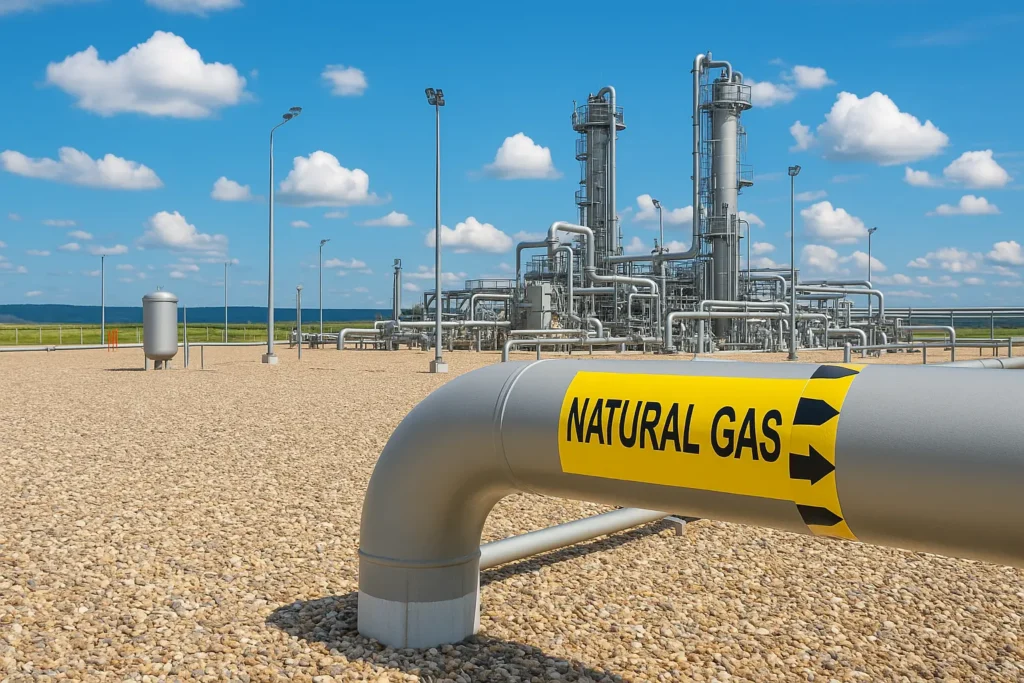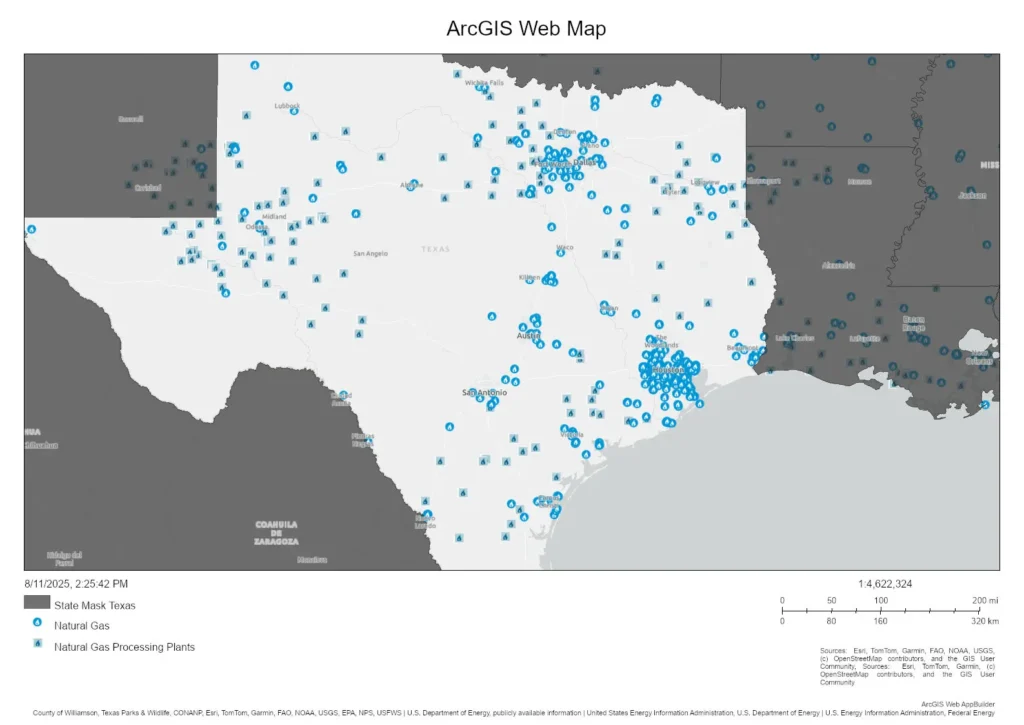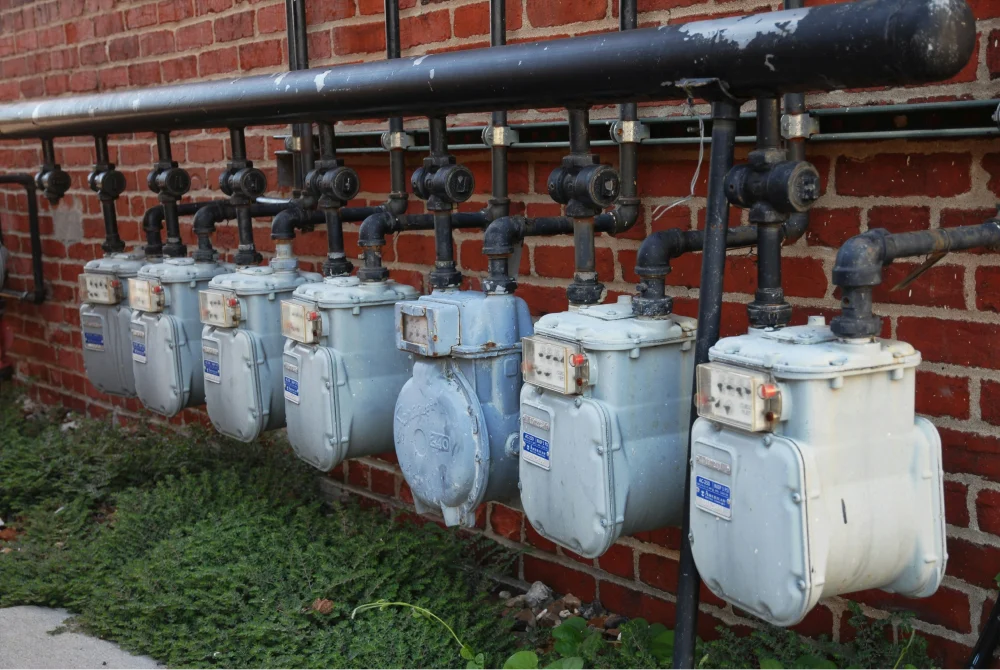Uses of Natural Gas: What Is It Used For?
3 minute readHow is natural gas used? In the Untied States, most natural gas is used for heating homes (as well as
Home > Learning Center > Energy Production > How Many Natural Gas Plants Are in Texas
How many natural gas plants operate in Texas? How many more are proposed amid surging energy demand?
3 minute read • Last update August 2025

The state operates more than 170 natural-gas-fired power plants, based on public databases and industry estimates. These range from small peaker units used during high-demand periods to massive combined-cycle facilities running year-round to meet base load needs.
Natural gas remains the backbone of Texas’s electricity supply in 2025, powering ERCOT’s dispatchable generation fleet. Natural gas accounts for over 41% of ERCOT’s total generation capacity in 2025, making it the single largest contributor to the state’s electricity supply. This blog explores where these plants are located, which are the largest, and the surge of new projects set to reshape the state’s energy landscape.
There isn’t one single place you can go to find an exact, up-to-date list of every natural gas power plant in Texas. ERCOT shares data on plants connected to its grid, but that leaves out facilities outside its footprint.
The U.S. Energy Information Administration (EIA) and Texas Comptroller’s Office also track plants, but their reports can lag behind real-world changes. Some private databases, like S&P Global Commodity Insights and Global Energy Monitor, are more complete, but they are often behind paywalls and do not always use consistent plant names.
That is why the commonly cited figure of more than 170 operating plants comes from combining information from several trusted sources instead of one master list.
In the map image extracted from EIA ArcGIS platform, you can see that most natural gas plants are concentrated around major Texas load centers such as Dallas–Fort Worth, Houston, Austin, and San Antonio. Strategic placement near transmission lines and fuel supply routes ensures consistent dispatch capabilities and reduces delivery risk.

Texas is home to several large-scale gas-fired power plants that provide critical capacity for ERCOT’s grid. These facilities often operate as combined-cycle plants, which use both gas turbines and steam turbines for higher efficiency.
| Plant Name | Capacity (MW) | Location | Type |
|---|---|---|---|
| Forney Energy Center | 1,824 | Forney, TX | Combined Cycle |
| Magic Valley Generating Station | 1,068 | Edinburg, TX | Combined Cycle |
| Wilkes Power Plant | 879 | Avinger, TX | Steam Turbine |
| Brazos Valley Power Plant | 875 | Thompsons, TX | Combined Cycle |
| Wolf Hollow Generating Station | 750 | Granbury, TX | Combined Cycle |
| Lost Pines Power Project 1 | 545 | Bastrop, TX | Combined Cycle |
These plants are critical for meeting peak demand, especially during heat waves and winter cold snaps when renewable output may fluctuate.
The state is experiencing a major development surge, with 130+ new natural gas power plant projects in various proposal stages as of 2025. If built, these facilities could add roughly 58 GW of new capacity.
A major driver is the Texas Energy Fund (TEF), which is offering financial incentives and low-interest loans to accelerate construction and bolster grid reliability.
One of the biggest forces behind this surge is the growth of artificial intelligence and data centers. These facilities demand uninterrupted, high-load electricity to operate, driving significant investment in dispatchable generation.
Cryptocurrency mining is another major contributor. These operations often cluster in regions with low wholesale energy prices, creating concentrated demand on the grid.
Extreme heat waves and volatile weather patterns are also pushing ERCOT to expand its supply of reliable generation. The grid operator needs more dispatchable capacity to meet peak demand and maintain stability during emergencies.
While natural gas plants offer fast ramp-up capabilities, their dependence on specific pipeline networks creates potential vulnerabilities. Single-source pipeline dependencies can lead to fuel supply bottlenecks during peak demand or extreme weather events.
On the regulatory side, environmental permitting through the Texas Commission on Environmental Quality (TCEQ) is facing increased scrutiny. Some facilities with high emissions profiles have avoided “major source” classification, allowing them to bypass more stringent federal reviews. This loophole is drawing attention from environmental groups and could see tighter oversight in the coming years.
With over 170 operational gas-fired plants producing more than 40% of Texas’ electricity, natural gas remains indispensable to grid stability. These facilities range from massive combined-cycle plants that run continuously to smaller peaker units dispatched during high-demand hours or emergencies.
Their flexibility and dispatchability make them essential for balancing the growing share of intermittent renewable energy resources like wind and solar.
The 130+ proposed natural gas plants mark one of the largest capacity expansions in Texas history. The growth is directly linked to population increases, industrial expansion, and the unique needs of energy-intensive sectors like AI and cloud computing.
Funding from the Texas Energy Fund is expediting timelines, but pipeline capacity limits, regulatory reviews, and environmental opposition could determine which projects ultimately move forward.
Natural gas will likely remain a cornerstone of Texas’ power supply for at least the next decade, but its expansion will increasingly intersect with policy debates over emissions, land use, and long-term grid resilience.
Graham Lumley, Digital Marketing Manager at BKV Energy, leads digital and traditional marketing strategies, focusing on educating Texans about the state's deregulated energy market. With over 8 years of marketing experience, he creates content to help consumers understand and save on their energy bills, bringing a fresh and dynamic approach to the industry.

How is natural gas used? In the Untied States, most natural gas is used for heating homes (as well as

Globally, and particularly within the United States, natural gas stands as a plentiful resource. Thanks to recent discoveries and advancements
Get $50 off your electric bill!
Use code BKVEJOINUS50
Enter your zip code to shop BKV Energy's affordable, fixed-rate Texas electricity plans. Use the promo code for $50 off your electric bill.